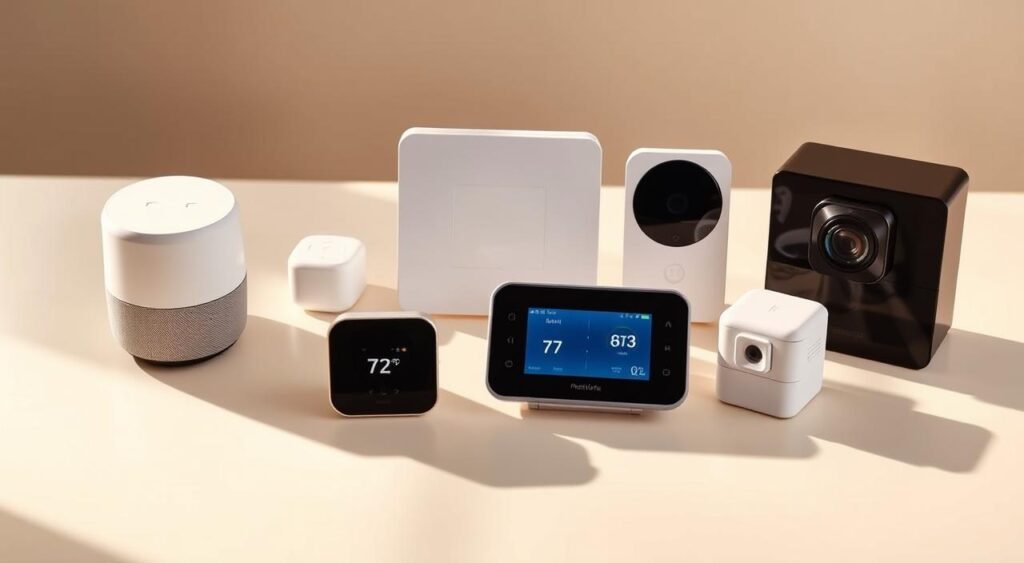Ever ponder how a few smart gadgets can transform your home into a high-tech sanctuary without a tech degree? Picture this: lights dimming as you say “goodnight” or a thermostat adjusting to your habits, cutting your energy bill by 15%. That’s the enchantment of a smart home, and it’s easier than you might think. This beginner’s guide to smart home reveals how voice commands, automated routines, and affordable devices can revamp your space. No coding needed, just a spark of curiosity!
Key Takeaways
- Smart home for beginners starts with voice assistants like Alexa or Google—control lights, locks, and music with just your voice.
- Smart thermostats save 15% on energy bills by learning your habits automatically.
- DIY-friendly options like smart plugs or lighting kits take under an hour to install, no electrician needed.
- Security systems with geofencing and live feeds protect your home even when you’re away.
- Smart home hubs like SmartThings or Apple HomeKit let you link devices seamlessly, but many gadgets work hub-free.
What Is a Smart Home? Understanding the Basics
A smart home is more than just gadgets; it’s a space that adjusts to your needs. Imagine your lights dimming as you relax, and your coffee maker brewing as your alarm sounds. This is smart home technology at work, making daily tasks easier. Whether it’s adjusting the thermostat or securing your home with a tap, it’s all about convenience.
Defining Smart Home Technology
At its heart, smart home basics involve devices connected to the internet. A smart light bulb, for instance, isn’t just a bulb; it’s a light that responds to your voice or phone. These devices use Wi-Fi or Bluetooth to communicate with systems like Alexa or Google Nest. Even your fridge can send you a notification if you’re out of milk!
How Smart Homes Have Evolved
In the 2000s, “smart” referred to clunky remote controls. Today, systems like Apple HomeKit or Philips Hue enable devices to work together seamlessly. The transition from single-purpose gadgets to a unified system has revolutionized the smart home. Now, your AC can adjust automatically when you’re away, and you’ll receive alerts if a window opens.
The Internet of Things (IoT) Explained Simply
IoT is the backbone of smart homes. It connects devices like your doorbell, lights, and TV on one network. This network allows devices to communicate, such as your security cam sending alerts when it detects motion. It’s like your home has a brain that learns your habits, adjusting the heat when you’re away or turning off lights you forgot.
Ready to explore more? The next sections will guide you through selecting devices, setting up hubs, and avoiding common mistakes. Your smart home journey begins with the smart home basics that transform convenience into reality.
Benefits of Creating a Smart Home for Beginners
Starting a smart home journey doesn’t need a tech degree; just a spark of curiosity. The smart home for dummies method is all about simplicity. Picture this: Your lights automatically turn off when you leave, or your thermostat adjusts to your daily routine. These benefits are not just dreams—they’re real today.
- Enhanced safety: Motion sensors and smart locks deter intruders.
- Energy savings: Smart thermostats can cut utility bills by 10-20%.
- Remote control: Adjust lights, locks, or cameras via your phone, even miles away.
- Fun upgrades: Voice commands for music, recipes, or movie recommendations.
| Hub Type | Compatibility | Best For |
|---|---|---|
| Google Home Hub | Works with 1,000+ devices from 150+ brands | Quick setups and voice commands fans |
| Amazon Echo (Alexa) | Supports for Alexa-enabled devices | Music lovers and voice-first control |
| Samsung SmartThings | Advanced automation (e.g., location-based settings) | Users craving customization |

Smart homes save a lot on energy. Smart lighting and thermostats keep your home cozy while cutting bills. Check this guide for more ways to save. Health benefits include air quality sensors that monitor allergens, improving your breathing. And for security, cameras and doorbells watch over your home 24/7.
Whether you’re new to tech or a gadget lover, these benefits are for everyone. Begin with something simple, like a smart plug or bulb, and expand your system over time. The future of home living is here. Ready to begin your smart home for dummies journey? It starts now!
Essential Smart Home Devices to Start Your Journey
“Feeling excited but not sure where to begin? I totally get it! The world of smart home devices can seem overwhelming, but I always recommend starting with a few key pieces that deliver big results with minimal effort.”
— Expert Tip
Let’s explore the smart home devices that transform your space into a tech-savvy haven effortlessly. These selections focus on easy smart home set-up and practical benefits.
Smart Speakers & Voice Assistants
Start with a voice assistant hub like the Amazon Echo (4th Gen) or Google Nest Audio. They serve as your command center, allowing you to play music, check the weather, or control lights. The Apple HomePod mini provides crisp sound and integrates seamlessly with Apple devices. Setup is quick, taking just minutes via the app!
Smart Lighting Solutions
Lighting sets the mood. The Philips Hue Color Ambiance lets you change room colors with 16 million options, while the Govee Wi-Fi LED Bulb offers Wi-Fi control at a lower cost. Both integrate with voice commands for an easy smart home set-up.
Connected Thermostats
Save energy and stay comfortable with the Google Nest Learning Thermostat or Ecobee Smart Thermostat. They learn your habits, adjust temperatures automatically, and reduce utility bills. No need to adjust dials manually!
Smart Security
Enhance security with cameras like the Ring Pan-Tilt Indoor Cam or Blink Outdoor 4. They offer motion alerts, night vision, and 1080p footage for peace of mind. Setup is quick, taking under 10 minutes via the app.
Begin with a single category, like adding a smart plug or thermostat, and watch your home evolve. Most devices pair effortlessly with your phone or voice commands. Ready to enhance your home? Let’s begin!
Setting a Realistic Budget for Your Smart Home
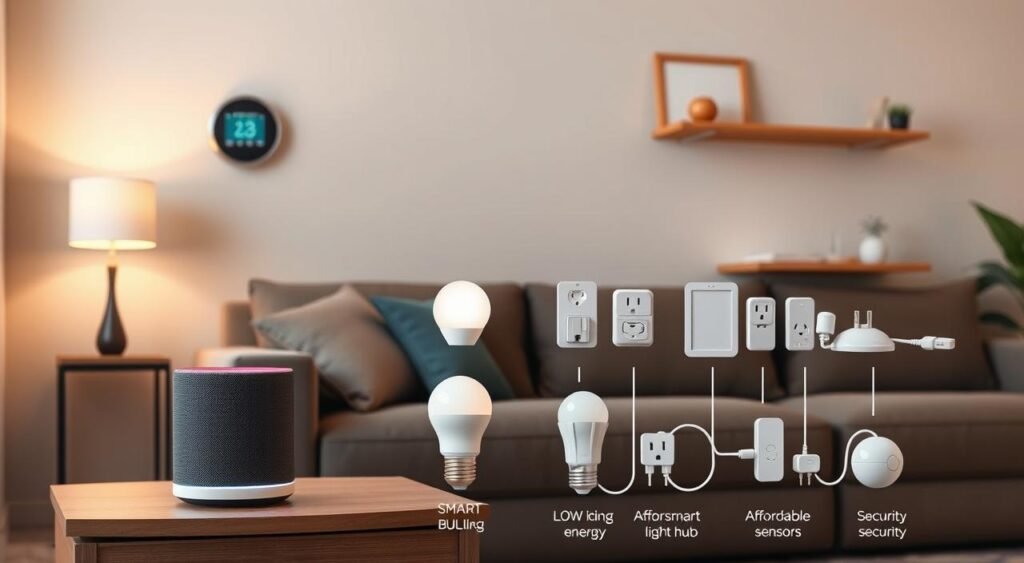
Starting smart means staying smart. Let’s discuss budget basics for asmart home for beginners. You don’t need a fortune to begin—just make smart choices. Begin with entry-level items under $100. Philips Hue bulbs are $15 each, and speakers like the Amazon Echo or Google Home Hub are under $50. These essentials offer voice control and automation without breaking the bank.
Mid-range options like Nest thermostats ($150–$250) or budget-friendly security cameras (Ring, Eufy, or Blink) allow for gradual expansion. Steer clear of subscription traps—opt for brands like Wyze or Meross for no-hidden-cost devices. Need proof? DIY upgrades like smart plugs or motion sensors can cut energy waste and costs by 15%–75%, making every dollar count.
- Start with voice assistants ($50) to control lights, music, and routines.
- Pair affordable motion sensors with Philips Hue bulbs for instant energy savings.
- Save on subscriptions by choosing brands like Eufy or Wyze.
Premium systems like whole-home automation may cost $500+, but they’re optional. Stay focused on your goals—security, energy savings, or convenience—to avoid overspending. Keep an eye out for sales like Prime Day or Black Friday, which can drop prices on hubs like the Echo Dot or Nest Mini. Remember, a beginner’s guide to smart home success isn’t about perfection—it’s about small wins. Tackle one problem each month, and watch your smart space grow without financial strain!
Connectivity Options: Wi-Fi, Bluetooth, Zigbee, and Z-Wave
When selecting connectivity for your smart home, it’s not just about speed. It’s about finding the right balance for your specific needs. Let’s explore the options to help you make an informed choice.
| Standard | Best For | Key Features | Examples |
|---|---|---|---|
| Wi-Fi | Streaming devices (cameras, TVs) | High speed, global reach, but drains battery | Ecobee thermostat, Nest cameras |
| Bluetooth | Audio, short-range gadgets | Easy setup, but slower for large networks | Sonos speakers, wireless headphones |
| Zigbee | Battery-powered sensors | Low power, mesh networking | Philips Hue lights, motion sensors |
| Z-Wave | Secure smart locks and hubs | Reliable range, requires a hub | August smart locks, Schlage systems |
Mesh networks can be confusing, but Zigbee and Z-Wave simplify things. They create networks between devices, extending coverage without Wi-Fi. For instance, the Eero 6 router (coming soon) supports Zigbee, making setup a breeze. Even the latest Amazon Echo models serve as Zigbee hubs, eliminating the need for extra hardware.
For an easy smart home set-up, align your goals with the right standard. Need to access your home remotely? Wi-Fi is your best bet. If battery life is a priority, Zigbee or Z-Wave are the way to go. If you’re unsure, start by identifying your essential devices. Then, choose the connection that best integrates them.
Step-by-Step Smart Home Set-Up Guide
Ready to dive into smart living? Let’s tackle easy smart home set-up with confidence. Whether you’re getting started with smart home tech or upgrading, this guide simplifies complex steps. Let’s get rolling!
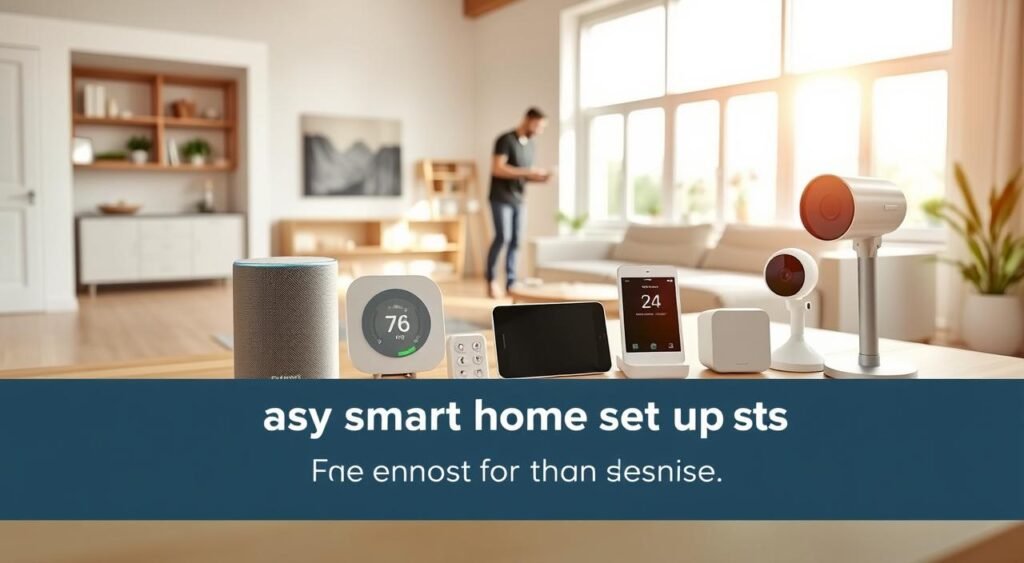
Planning Your Smart Home Layout
Begin by mapping your space. Ask: “Which rooms need smart lights?” or “Where’s the best spot for a security camera?”. Use sticky notes to mark device locations. Remember, always leave space near outlets for hubs or repeaters!
Setting Up Your Home Network
Strong Wi-Fi is your smart home’s backbone. Use this checklist:
- Upgrade to a dual-band router (like Netgear Nighthawk AX12) for lag-free control
- Test signal strength in every room with the Fing app
- Reserve a dedicated network band for IoT devices
Installing Your First Smart Devices
| Step | Action |
|---|---|
| 1 | Download the hub or brand-specific app first |
| 2 | Keep packaging until setup’s confirmed – QR codes are lifesavers! |
| 3 | Pair devices in the same room as the hub to ensure connection |
Troubleshooting Common Setup Issues
Hit a snag? Try these quick fixes:
- Flashing lights? Check if the device is within 20 feet of the router
- App not responding? Restart both the device and your router
- Conflicting commands?! Reboot your voice assistant hub
“Always test routines after setup – like a ‘movie time’ sequence dimming lights and lowering temps. It’s the fun part!” – Smart Home Pro Installer, TechSetup Co.
Need help? Most brands offer live chat support during setup. Remember, even pros start small. Celebrate each success – like your first voice-activated light! Let’s keep buildingin smarter systems next section!
Smart Home Hubs: Do You Need One?
Deciding between a hub or a hub-free setup depends on your smart home basics objectives. For a small setup with a few devices, a hub might not be necessary. Yet, as your system expands, a hub significantly enhances your experience. Let’s explore the details.
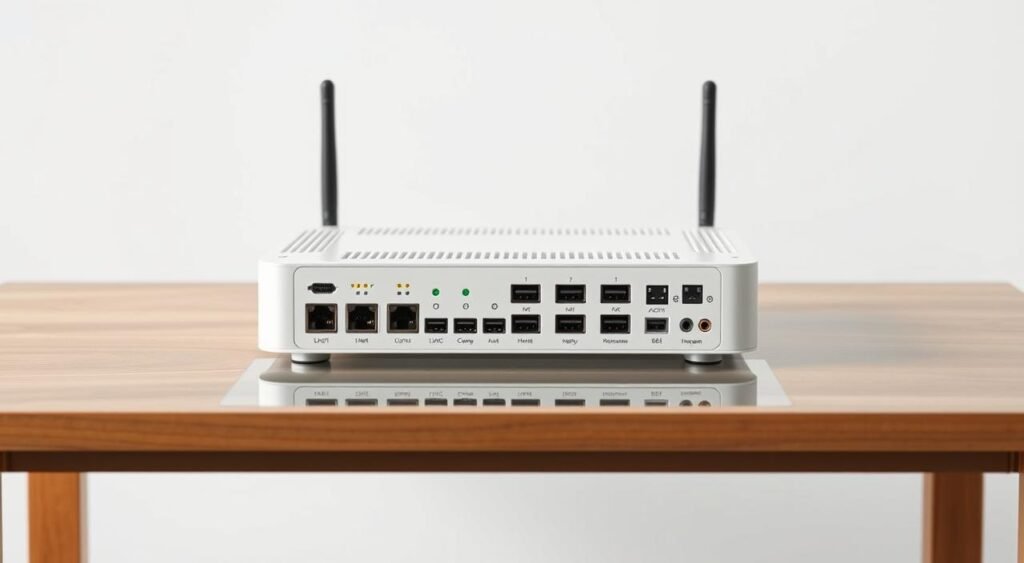
Picture this: You have a Wi-Fi thermostat, a Zigbee lock, and a Z-Wave doorbell. Without a hub, managing these through separate apps can be chaotic. A hub serves as the central controller, integrating these devices into a unified system. But is the investment worthwhile? Let’s examine the options.
| Brand | Protocols Supported | Key Features | Best For |
|---|---|---|---|
| Wink Hub 2 | Z-Wave, Zigbee, Wi-Fi | Local automation, offline control | Hybrid setups mixing brands |
| Samsung SmartThings Hub | Z-Wave, Zigbee, Thread | Custom routines, Matter compatibility | Futuristic tech enthusiasts |
For smaller systems, voice assistants like Alexa, Google Home, or Apple HomeKit are effective. They allow voice control but have limitations when integrating non-ecosystem devices. For instance, Nest cameras work well with Google Home, but combining Philips Hue lights with Sonos speakers requires a hub.
Do you need a hub? Here are the scenarios:
- You use devices from 3+ brands
- Want offline smart home automation during internet outages
- Enjoy creating complex routines (e.g., lights dim when motion sensors detect no movement)
Indecisive? Begin with voice assistants. If you encounter issues like slow controls or app overload, consider a hub. The ideal setup evolves with your needs. Ask yourself, “Is my system becoming too complex?” If yes, it’s time to centralize!
Voice Command Fundamentals: Alexa, Google Assistant, and Siri
Imagine controlling your smart home technology with just your voice—no buttons, no apps. Voice assistants like Alexa, Google Assistant, and Siri make life easier. Let’s explore how it works step by step!
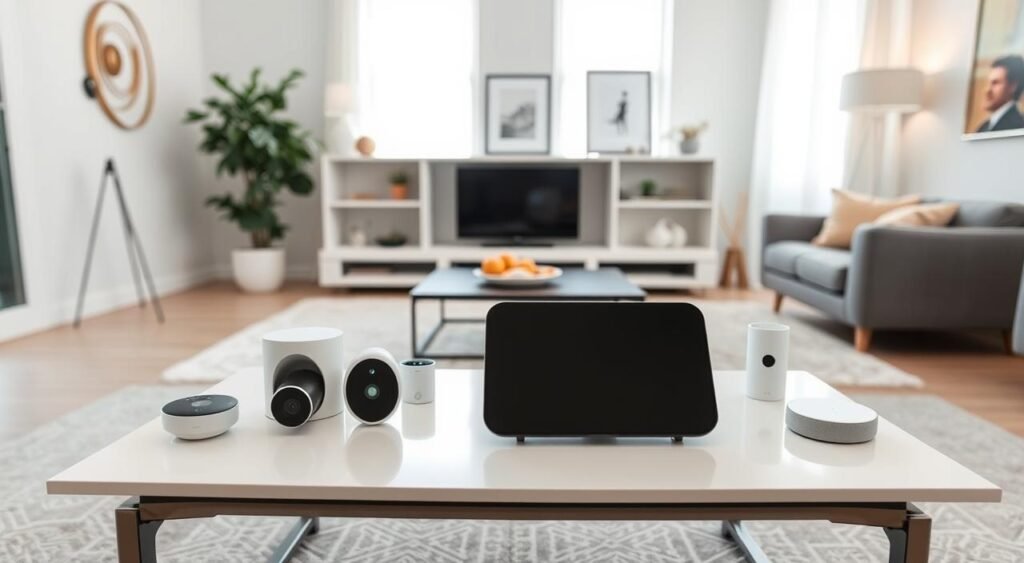
Here’s how it works: say “Hey Google, turn off the living room lights” or “Alexa, play jazz on Spotify.” These commands use smart home for dummies-friendly terms. Try these everyday tasks:
- Adjust lights: “Dim the kitchen lights to 50%.”
- Manage schedules: “Set a reminder to water plants tomorrow.”
- Stream media: “Play my morning playlist!”
- Order groceries: “Add milk to my Instacart list.”
| Assistant | Key Features |
|---|---|
| Alexa | Works with thousands of devices, supports multi-room audio |
| Google Assistant | Excels in contextual understanding, integrates with Android |
| Siri | Seamlessly connects Apple devices, great for quick searches |
Pro tip: Use wake words like “Alexa” or “Hey Google” to activate commands. Need help? Say, “Alexa, what can you do?” to explore options. By 2026, this tech will be a $30 billion industry—so jump in now! Start small: pick one task (like setting a timer) and grow from there. Your smart home journey is just a voice command away!
Creating Smart Home Routines and Automation
Imagine your home anticipating your needs before you even ask. This is the essence of smart home automation, where devices work together seamlessly. Whether you’re new to smart home for beginners or an experienced user, routines make technology more efficient. Let’s dive into how to set up systems that save time, energy, and enhance your peace of mind.
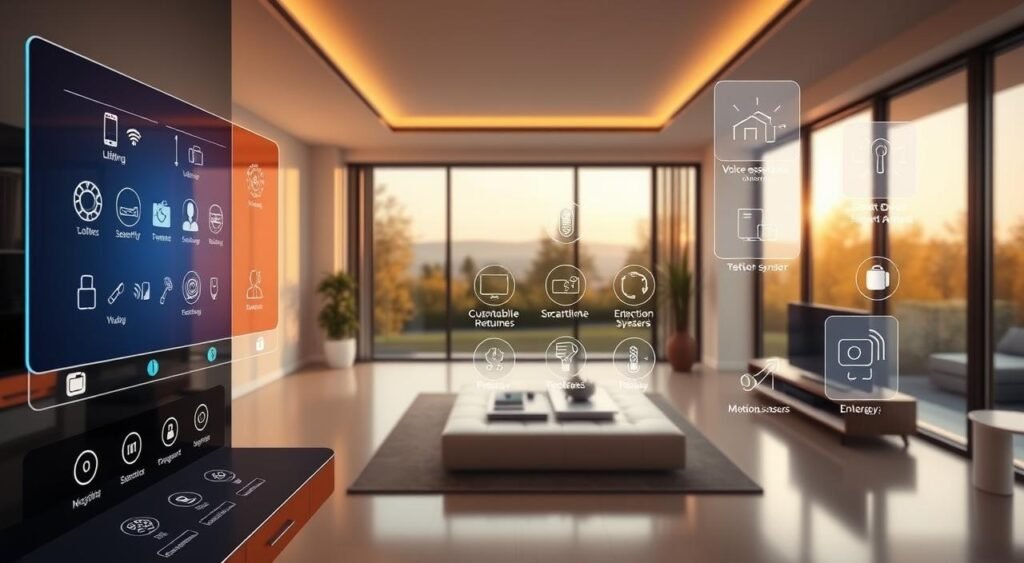
“My ‘good morning’ routine plays my podcast, turns on lights, and warms the coffee maker—all before I hit snooze!” – Sarah, a first-time smart home user
Begin with everyday routines:
- Morning & Evening Routines: Program your system to wake you with gentle light, play news updates, or even brew coffee. At night, dim lights, lock doors, and set the thermostat for restful sleep.
- Vacation Mode Automation: Keep burglars guessing with random light flickers, motion-activated cameras, and “occupied” sounds. Apps like Google Home let you trigger these with a single tap.
- Energy-Saving Automations: Set thermostats to adjust when rooms are empty. Smart plugs can turn off idle devices, slashing bills without manual effort.
Apps like IFTTT or Samsung SmartThings enable you to create custom scripts. Even beginners can link actions: “If sunset arrives, turn on porch lights AND play jazz.” Experiment safely—most systems let you pause or delete routines anytime. The aim is to have a home that learns your habits and responds like a trusted partner.
Privacy and Security Considerations for Smart Homes
Let’s explore the smart home basics for maintaining safety. A beginner’s guide to smart home security emphasizes awareness. Devices like cameras or voice assistants collect data, so safeguard it.

- Lock down defaults: Alter default passwords. Remember, “admin” is a common target.
- Enable multi-factor authentication (MFA): This adds an extra layer of protection against unauthorized access.
- Update constantly: Regular updates fix security holes. Enable auto-updates for devices like Nest or Philips Hue.
In 2020, Amazon Ring faced a $8M FTC settlement for exposing camera feeds. Avoid such issues. The beginner’s guide to smart home includes:
- Network segmentation: Use a guest Wi-Fi for smart devices. Keep your main network secure.
- Check privacy policies: Look for brands like Apple’s HomeKit, which use end-to-end encryption.
- Disable unused features: Turn off voice recording if you don’t use it. Less data means less risk.
Securing your smart home is straightforward. Begin with simple steps, like enabling MFA on Google Home or Alexa. Every action you take contributes to your safety. Stay vigilant and keep your home secure!
Common Mistakes in Smart Home for Beginners
Embarking on your smart home journey is exciting, but it’s essential to sidestep common pitfalls. Understanding what to avoid when getting started with smart home technology is key.
- Overcomplicating from day one: Don’t try to automate your entire home at the start. It’s like over-fertilizing your lawn—see lawn care lessons. Begin with one room or task.
- Ignoring brand compatibility: Mixing brands without ensuring they work together can lead to app chaos. It’s like trying to tame untamed hedges without the right tools.
- Weak Wi-Fi?: A slow network can turn smart lights into flickering mysteries. Ensure your Wi-Fi is strong before diving in.
- No central hub: Managing multiple apps can be draining. A central hub simplifies control, making life easier.
- Skipping updates: Outdated software poses security risks. Regularly update firmware, just as you would mow your lawn.
- Overlooking security: Hackers target unsecured systems. Use strong passwords to protect your home from common vulnerabilities.

“The biggest mistake? Thinking smart homes need to be perfect day one. Start with what matters most to you,” says tech advisor Sarah Lin. “Progress beats perfection.”
Success in Smart home for beginners comes from small victories. Focus on one problem, like late-night light switches, and build from there. For complex setups, consider seeking professional advice. And remember, trial and error is part of the fun!
Compatibility Issues: Ensuring Your Devices Work Together
Ever wondered why some smart home devices don’t get along? Let’s dive into compatibility issues! As someone who’s helped many homeowners, I’ve picked up some essential tips. These will ensure your setup runs smoothly.
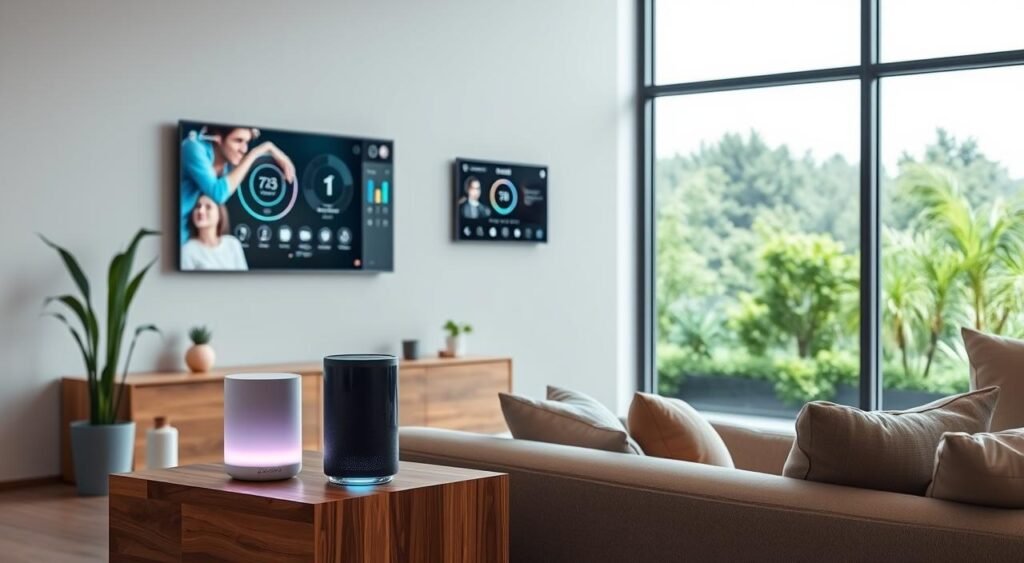
“Will this work with that?” It’s the question I hear most from clients. And it’s a valid concern! Compatibility is key to a seamless smart home experience.
First, look for compatibility logos. Check for Works with Alexa, Google Assistant, or HomeKit labels. These logos confirm your devices will work with your voice assistant. If you’re unsure, check the box or product page for details like Zigbee, Z-Wave, or Wi-Fi support.
Major Ecosystems Explained
| Ecosystem | Key Features | Top Brands |
|---|---|---|
| Amazon Alexa | Voice commands, vast app support | Philips Hue, Ring |
| Google Home | Seamless Chromecast integration | Nest, Philips |
| Apple HomeKit | Privacy-focused, iOS integration | Lutron, Elgato |
Cross-Platform Solutions
Choose a central hub like the Google Nest Hub or Amazon Echo. It will be your command center. Here are some tips to pair with it:
- Use a Zigbee bridge to connect older devices to your Wi-Fi
- Choose multi-protocol devices (e.g., Samsung SmartThings) for cross-ecosystem use
- Enable automatic updates to keep your system’s firmware current
The Matter protocol is now bridging gaps between brands. This makes setting up devices from different ecosystems easier than ever. Start with a few devices, check for logos, and let your hub handle the rest. Your easy smart home set-up will appreciate it!
Beyond the Basics: Expanding Your Smart Home
Ready to elevate your smart home experience? Let’s dive into upgrades that transform everyday spaces into innovation hubs. Picture a kitchen that cooks for you, a media room that adjusts to your mood, or an outdoor area that manages itself. Smart home devices and automation are not just for tech enthusiasts. They’re for anyone looking to enhance convenience.
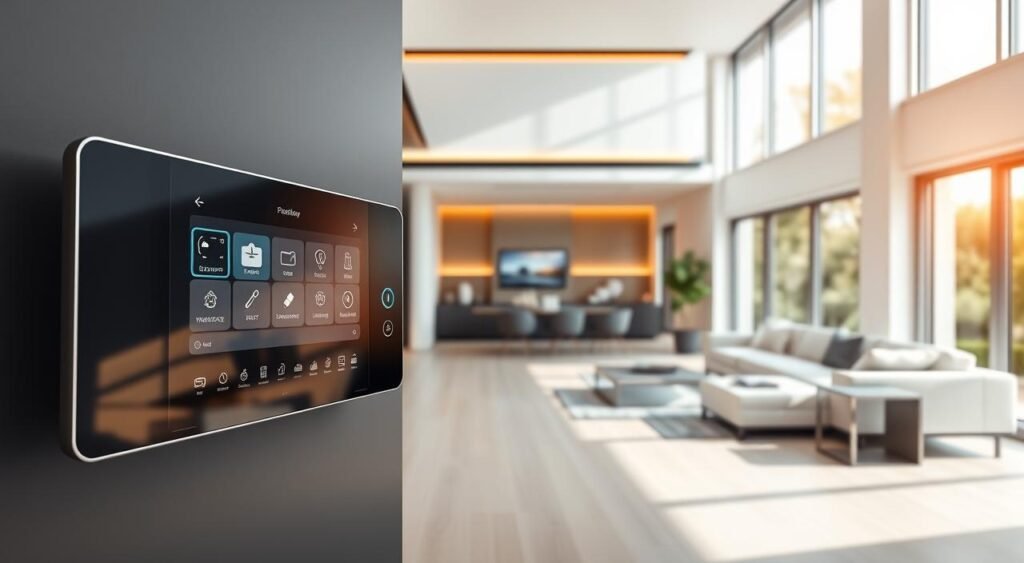
Smart Kitchen and Appliances
Your kitchen can become a chef’s dream. Smart grills like the Weber Connect allow you to set up ribs for perfection via app. Add smart ovens or refrigerators that track your groceries. Begin with these simple steps:
- Rachio sprinkler systems adjust watering based on weather.
- Roborock robotic mowers cut grass automatically.
- Aqara Camera Hub G5 Pro monitors outdoor areas with 4K resolution.
Entertainment and Media Room Automation
| Device | Feature | Brand |
|---|---|---|
| Motorized projection screens | Lower with voice commands | Motorized Home Solutions |
| Smart AV receivers | Adjust audio for movies or music | Denon, Sonos |
| Lighting strips | Sync colors to movies | LIFX, Philips Hue |
Transform your living room into a theater with just one tap!
Outdoor Smart Home Extensions
Your yard deserves smart tech too! Combine outdoor devices with smart home automation for seamless control:
- Aqara Camera Hub G3 keeps watch day or night.
- Solar-powered path lights that activate with motion.
- Smart pool heaters that adjust temps via app.
Begin with one area, then expand. Each upgrade adds to your comfort.
Real User Stories: Transformations With Simple Smart Home Tech
Let’s ditch the tech jargon—real stories show how smart home for dummies can change daily life. One client I worked with installed a video doorbell before a vacation. They texted me later:
“Seeing my package delivered in real time? That’s peace of mind!”
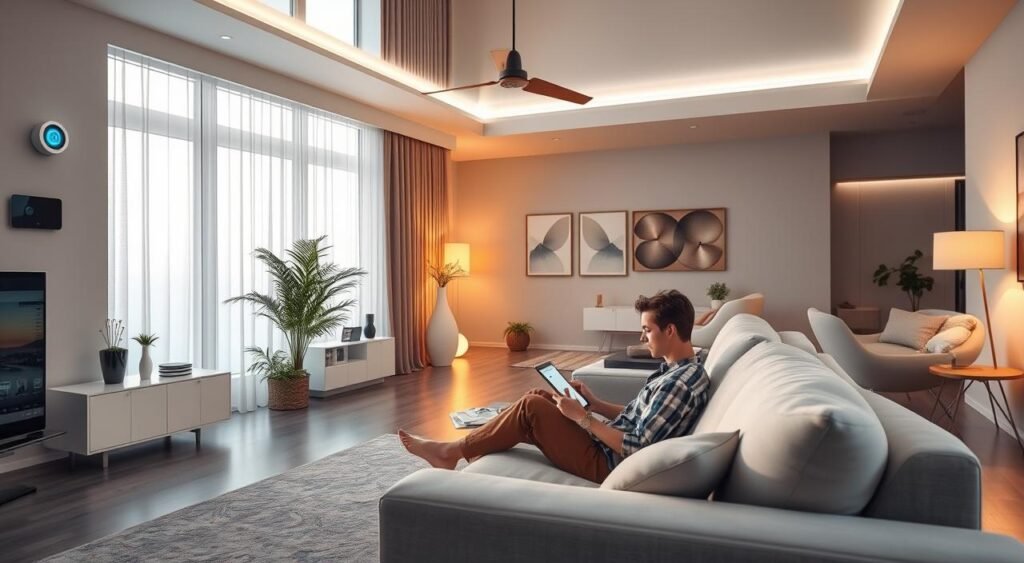
Another homeowner slashed their energy bill by 15% with a Nest thermostat. It learned their schedule and adjusted heat automatically—no more wasted energy! Philips Hue lights cut their lighting costs by 20% too. They now set scenes with voice commands, like “Evening Mood,” making evenings cozy without lifting a finger.
Smart home automation isn’t just for tech pros. A family with young kids uses a Ring system to monitor their door and garage. Alerts pop up on their phones when the school bus arrives—no missed pick-ups ever again. And a retiree I know uses voice commands to control lights and temperature, making their home safer and easier to navigate.
Ready to start? Begin small: a smart bulb or speaker. These tools prove even basic setups save time and cash. Every story I’ve seen shows one truth—smart homes aren’t about complexity. They’re about solving real problems in ways anyone can master. Your next upgrade could be just a click away!
Conclusion: Taking the First Steps in Your Smart Home Journey
Embarking on a smart home journey doesn’t have to be daunting. For smart home for beginners, begin with basic devices. Consider smart door locks that auto-lock or smart plugs that integrate with Alexa or Google Assistant. Start by focusing on one area, like securing your entryway with a Ring Video Doorbell or optimizing energy use with a Nest thermostat.
Choose devices that address your everyday needs. Automate your lighting with Philips Hue or monitor energy costs with smart meters. This approach ensures your smart home setup is both practical and efficient.
The foundation of an easy smart home set-up lies in compatibility. Opt for devices from ecosystems like Apple HomeKit or Samsung SmartThings for seamless integration. Take it one step at a time, starting with something as simple as a smart outlet to control lamps remotely. Always check app reviews to ensure a hassle-free setup process.
Set achievable goals for your smart home. Perhaps you aim to save time, reduce bills, or enhance safety. Begin with small steps, mastering the basics before expanding. Each step you take brings you closer to a home that operates more efficiently for you. Are you ready to start? Choose a device today and witness how it can simplify your life. The journey begins now!
FAQ
What exactly is a smart home?
A smart home integrates devices like lights, thermostats, and locks through the internet. This integration enhances daily life, making it more convenient. It’s about turning everyday objects into smart home technology.
What are the benefits of creating a smart home?
Smart homes offer convenience, energy savings, and enhanced security. They automate daily tasks, saving time and money. Enjoying greater comfort is a bonus!
How do I start building a smart home?
Start with essential devices like smart speakers, lighting, and thermostats. Gradually add more as you get the hang of it. This approach helps you manage your smart home system effectively.
What is the cost of setting up a smart home?
Costs vary based on the devices you choose. Basic setups are under 0, while advanced systems are pricier. Start small and grow your smart home as your budget allows.
How do smart home devices connect to each other?
Devices connect via Wi-Fi, Bluetooth, Zigbee, and Z-Wave. Knowing these options helps you pick compatible devices for a seamless experience.
Do I need a smart home hub?
A hub isn’t always necessary. Many devices work independently through their apps. Decide based on your needs and preferences.
How can I use voice commands in my smart home?
Use Amazon Alexa, Google Assistant, or Apple Siri for hands-free control. Set up routines for a smoother experience.
What are smart home routines, and why are they important?
Routines automate tasks, making life easier. For example, a “Good Morning” routine can adjust the thermostat and turn on lights as you wake up.
How do I ensure my smart home is secure?
Use strong passwords, secure your network, and keep software updated. Be cautious with data-sharing settings. Stay informed about privacy to keep your smart home safe.
What common mistakes should I avoid as a beginner?
Avoid compatibility issues, neglecting network security, and overbuying. Research and plan carefully to avoid these mistakes.
How can I expand my smart home beyond the basics?
Explore advanced options like smart kitchen appliances and outdoor extensions. Once you’ve mastered the basics, the possibilities are endless.
